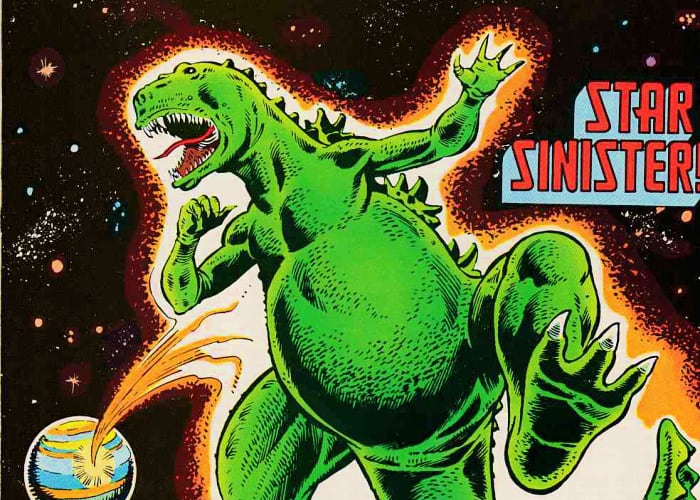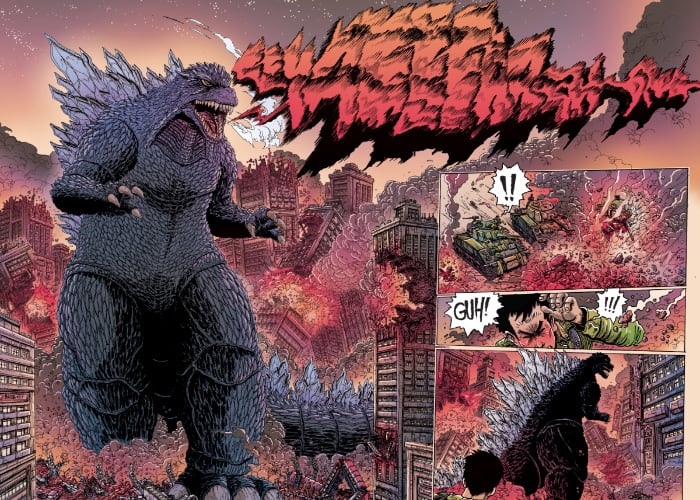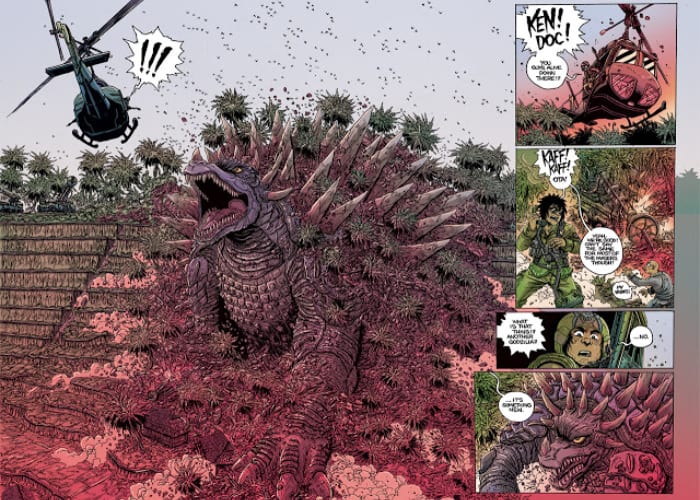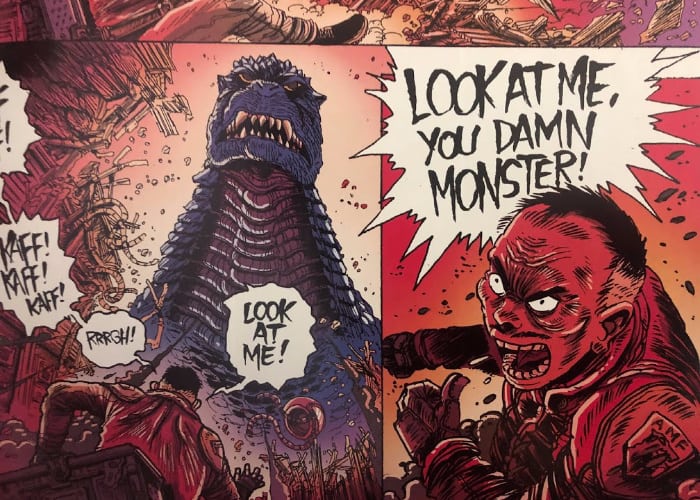Welcome to Pitch Meeting, a monthly column in which we suggest an IP ripe for adaptation, then assign the cast and crew of our dreams.
Godzilla is a very good boy. Few monsters or film franchises can compare to the legacy he’s left since his creation sixty-six years ago. Every few months or so, someone around the FSR offices gets the itch to pen a love letter to the King of Kaijus. He’s our guy, and his myriad of cinematic appearances range from the utterly goofy and glorious (Godzilla vs. Hedorah) to the most somber and tragic (Shin Godzilla). He was born of real-world horror, but over the decades, he’s learned to relax, and once an audience begins to take him for granted, he snaps back. Hard.
Hollywood periodically gravitates to the big G as well, and we don’t really mind. Even the ’98 riff has its fans (or fan) on this site, and while neither Gareth Edwards or Michael Dougherty‘s bouts with the titan can compare to the heights of the Shōwa era (1954–1975), we won’t kick Godzilla vs. Kong outta bed when it arrives sometime in the near future (currently scheduled for a November 20th release date). As is the case with characters like Batman and Spider-Man, we’re here for all adaptations, but given our druthers, we know how we’d do it if given a chance.
The perfect Godzilla movie exists. All we need to do is rip it free from the pages of James Stokoe‘s Godzilla: The Half–Century War and transplant it as close to the original vision as possible. This isn’t the early aughts. We don’t have to leather-up the X-Men anymore. Accept that you cannot add to perfection; make it your mission to preserve the coolness already emanating from the source material. Adaptation is not a game of addition, but of replication.
In Japan, Godzilla comics have been around nearly as long as the films themselves, but the majority of the earliest titles were sequential translations of the movies. In the states, Godzilla had a brief stint with a solo title at Marvel Comics. Lasting a mere twenty-four issues, the comic made slight references to the Toho productions, but tricky copyright laws made it impossible to revel in the weird and wild mythology of the character.

Godzilla comics didn’t start to become their own unique endeavor until the late ’80s when Dark Horse Comics scored the license for a couple of decades. There are some gnarly treasures to be collected from this period, especially whenever Arthur Adams puts his pencils to the beast (if you want your best bang for your buck, nab Art Adams‘ Creature Features, which also contains a killer adaptation of The Creature from the Black Lagoon).
One could curate a solid addiction wading through these various Godzilla interpretations, and while many of them are damn good, none can compete with the movies…well, several are better than the ’98 blockbuster (sorry Kieran). For my money, Godzilla comics did not become legit material until IDW started publishing them in 2010, and five years later, they would deliver what I consider to be one of the Top 5 Godzilla stories, full stop.
The Half–Century War recounts the fifty-year obsession of Ota Murakami, who, in 1954, witnessed Godzilla’s arrival in Shinagawa on the back of a tank. As the titan tears through buildings like papier-mâché, Murakami can’t decide where his emotions should rest. Is this beast meant to elicit abject horror or all-consuming awe? He is a god made of scales, teeth, and atomic breath, a creature that cannot possibly be allowed to roam the globe unchecked.
Murakami volunteers for the Anti-Magalasaurus Force (AMF), a military division devoted to solving the Godzilla problem. The good people of Japan were no match for their opponent on their first meeting, but they would be ready for him on their second. When a pest outgrows your ammunition, you better build a bigger gun.

The second issue jumps to 1967 and the hot jungles of Vietnam. As the films began in horror, so does The Half–Century War, but with each issue, the terror recedes a little bit, and the wonder takes over. Murakami is falling in love with Godzilla, and the affair is solidified when other kaijus crack through the Earth.
The Half–Century War is the Batman: The Long Halloween of Godzilla comics. If you’re already a comic-head, you know what I mean, but if you’re not, let’s try a more appropriate cinematic analogy. The Half–Century War is the Rocketman of Godzilla mythology. When you purchase a ticket to an Elton John biopic, you want the film to play all the hits, right?
The Half–Century War is the greatest Best of Godzilla album ever produced. As Murakami ages, hopping around the globe, chasing Godzilla from Japan to Vietnam to Ghana to Bombay to Antarctica, he also comes face to face with nearly all of your favorite kaiju adversaries. Anguirus, Rodan, Battra, Megalon, Kumonga, Mothra, Ebirah, Hedorah, and many more (it would be criminal to spoil a few of the surprises, even if you could probably guess — yeah, yeah, okay, King Ghidorah is there) make an appearance.
The comic isn’t fluff either. While it’s jammed to the edges with monsters and monster brawls, Stokoe keeps the story rooted in Murakami’s experience. It’s the strategy Gareth Edwards attempted in his 2014 film, but Stokoe dares to breathe as much life into his hero as he does the creatures that are constantly trying to stomp the puny human. Murakami saw God in Godzilla, and all he wants is for God to see him. The Half–Century War struggles with creation and the existential dread of one man’s purpose on a planet overflowing with specks just like him.
Murakami’s soul-devouring confrontation with mortality and human insignificance through the gaze of Godzilla demands to be on the silver screen. It is a take on the franchise we have not yet seen while also providing an absurd collection of behemoths that would make Destroy All Monsters blush. Oh. My. God — take it away, Bradley Whitford — “zilla.”

To achieve such a ponderous bout of popcorn entertainment, we need a director who not only understands and appreciates comic book spectacle but happily venerates it as well. Action as high art? Only one name sprang to mind: George Miller.
Mad Max: Fury Road is a masterpiece. Find me a person who doesn’t believe so, and I’ll find you a liar or a willful contrarian. Miller and his team spent decades stewing on the apocalypse, perfecting on ideas previously bandied about in three other action movie gems. The world was crafted through careful consideration and built on the backs of cartoonists like Brendan McCarthy (who co-wrote the script), Peter Pound, and Mark Sexton. James Stokoe’s anime/manga-influenced art could fit right alongside theirs in The Art of Mad Max: Fury Road.
The worlds of The Half-Century War and Fury Road are very, very different, but both share an uncaring landscape where humans strain to survive and maintain faith. Should Miller find Godzilla half as enticing as Murakami and Stokoe do, then the director could bring an extraordinary level of DIY craft to a franchise that, in Hollywood, is too often lost behind a CGI paintbrush. I’m not asking for rubber suits here (although I would not be opposed to them either), but Miller is a tactical creator who relishes the physical interaction with imagination. Better still, he never looks down to the material he’s concocting, choosing to strive to its heights rather than bring it down to his level.
Casting Murakami is a little trickier. The role demands a performer who can either act through a mo-cap or makeup aging process. You could rotate through a couple of actors, but after experiencing the bliss of the singular performance in The Irishman, I’m inclined to trap one man in Murakami.

Masaharu Fukuyama is my Ota Murakami. In the 2013 film Like Father, Like Son, Fukuyama plays the titular dad who discovers that his son was switched at birth, and who must now give up the child he raised for the one he’s never seen before. The movie is an absolutely brutal melodrama, skipping straight past the heartstrings, and jabbing the organ with blunt force.
Fukuyama wails with the best of them, and I would like to see that yowl transferred to one of the cosmic terror variety. Watching Murakami’s brain, via his eyes, process the concept of Godzilla over fifty years is a tantalizing proposition, and one Fukuyama could sell. He is a walking nerve. Let him vibrate against the titan.
Godzilla is like James Bond. They’re never going to stop making his movies. He may take a break from the cinema for a year or two, but sooner or later, another creator will take a swing, and as previously stated, we will be there for all of them.
The Godzilla comics go unseen by mainstream consumers and are mostly dismissed by comic book readers. We only need to place The Half–Century War in the hands of more folks. One flip through its pages and your eyes will go nearly as wide as Murakami’s. Commit to a proper reading, and you’ll be blathering about its beauty like this fool click-clacking away on his computer. Frankly, I can’t imagine anyone attempting any other Godzilla story until they’ve seen The Half–Century War rendered dutifully and passionately on screen.
0 comments:
Post a Comment